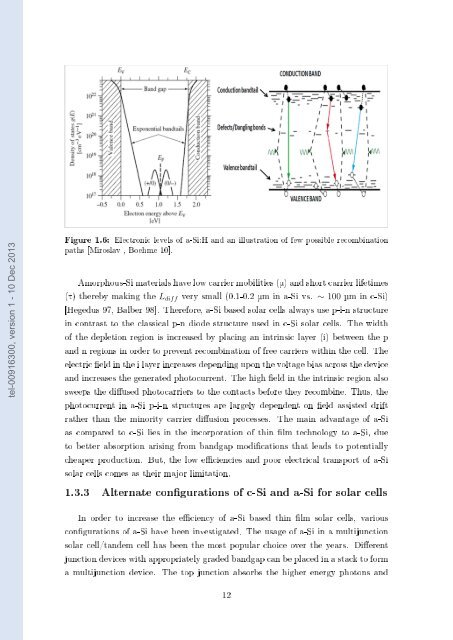Films minces à base de Si nanostructuré pour des cellules ...
Films minces à base de Si nanostructuré pour des cellules ...
Films minces à base de Si nanostructuré pour des cellules ...
Create successful ePaper yourself
Turn your PDF publications into a flip-book with our unique Google optimized e-Paper software.
tel-00916300, version 1 - 10 Dec 2013<br />
Figure 1.6: Electronic levels of a-<strong>Si</strong>:H and an illustration of few possible recombination<br />
paths [Miroslav , Boehme 10].<br />
Amorphous-<strong>Si</strong> materials have low carrier mobilities (m) and short carrier lifetimes<br />
(t) thereby making the L diff very small (0.1-0.2 mm in a-<strong>Si</strong> vs. ∼ 100 µm in c-<strong>Si</strong>)<br />
[Hegedus 97, Balber 98]. Therefore, a-<strong>Si</strong> <strong>base</strong>d solar cells always use p-i-n structure<br />
in contrast to the classical p-n dio<strong>de</strong> structure used in c-<strong>Si</strong> solar cells. The width<br />
of the <strong>de</strong>pletion region is increased by placing an intrinsic layer (i) between the p<br />
and n regions in or<strong>de</strong>r to prevent recombination of free carriers within the cell. The<br />
electric eld in the i layer increases <strong>de</strong>pending upon the voltage bias across the <strong>de</strong>vice<br />
and increases the generated photocurrent. The high eld in the intrinsic region also<br />
sweeps the diused photocarriers to the contacts before they recombine. Thus, the<br />
photocurrent in a-<strong>Si</strong> p-i-n structures are largely <strong>de</strong>pen<strong>de</strong>nt on eld assisted drift<br />
rather than the minority carrier diusion processes. The main advantage of a-<strong>Si</strong><br />
as compared to c-<strong>Si</strong> lies in the incorporation of thin lm technology to a-<strong>Si</strong>, due<br />
to better absorption arising from bandgap modications that leads to potentially<br />
cheaper production. But, the low eciencies and poor electrical transport of a-<strong>Si</strong><br />
solar cells comes as their major limitation.<br />
1.3.3 Alternate congurations of c-<strong>Si</strong> and a-<strong>Si</strong> for solar cells<br />
In or<strong>de</strong>r to increase the eciency of a-<strong>Si</strong> <strong>base</strong>d thin lm solar cells, various<br />
congurations of a-<strong>Si</strong> have been investigated. The usage of a-<strong>Si</strong> in a multijunction<br />
solar cell/tan<strong>de</strong>m cell has been the most popular choice over the years. Dierent<br />
junction <strong>de</strong>vices with appropriately gra<strong>de</strong>d bandgap can be placed in a stack to form<br />
a multijunction <strong>de</strong>vice. The top junction absorbs the higher energy photons and<br />
12
















